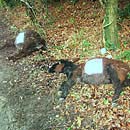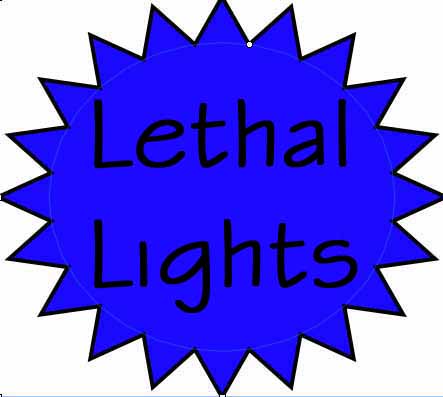New Forest animals are being killed by blinded drivers..
This tragic story by Sue Westwood about New Forest Ponies and other animals being killed is touching. It illustrates our case against blinding each other with light perfectly - in urban areas it could just as easily be your child or a cyclist . . . . . .
| Hit and Run Accidents
There is a reward of £1000 for information leading to the successful prosecution of drivers convicted of a HIT & RUN accidents involving a Forest animal. Example: Two donkeys (Sooty and Sweep) were hit in the village of Brook. The driver of the vehicle involved failed to report the accident. |
 Sooty and Sweep - tragic |
Livestock Deaths Drive with care in the Forest - 75 livestock were killed in 2009, unfortunately an increase from 2008. A further 37 animals were injured (excluding deer) |
Dear Ken,
I am impressed to hear you are running your own road safety campaign. As a professional driver, I bet you get very frustrated with some of the drivers on our roads. We have some awful accidents in the Forest with the ponies and other livestock. Many are due to lack of awareness and we do our best to educate drivers who use the Forest's unfenced roads. Some accidents are the result of excess speed, but not many.
| A lot occur simply because drivers think that the animals have road sense and therefore won't step out in front of their vehicle. Of course the animals don't have that sort of sense and don't realise the vehicle will kill or maim them and the result is that if the pony decides to cross the road, because the driver has failed to slow down or move over to pass the animal, there is a collision | " Drivers who hit animals at night quite often claim they have been dazzled by oncoming headlights and they say they didn't see the animal until it was too late " |
Then of course we have the night time accidents which are of particular interest to you. I think your customer is right. Drivers who hit animals at night quite often claim they have been dazzled by oncoming headlights and they say they didn't see the animal until it was too late.
Personally, I avoid the unfenced roads at night if I possibly can, but I am obliged to use one for a couple of miles on my way home every evening. I come off a fenced 60 mph 'A' road onto an unfenced 'B' road. The B road is a 40 mph zone but I always have someone right on my bumper trying to get me to go faster - which I won't! Much of this particular road, which has a lot of bends, is lined with trees and so very dark.
In order to be safe, I find I really need to be travelling at 30 mph or less if there are vehicles coming towards me.
I wear glasses which doesn't help but my eyesight is perfectly good with them. However, I often find I am unable to see very far ahead if there is an oncoming vehicle approaching with bright lights. Some modern vehicles do seem to have particularly bright lights which makes it very difficult to see much at all ahead of you on a pitch dark Forest road. I am an experienced driver, and until last year (when I didn't bother to renew it)
I held an HGV 1 licence so I think I am a reasonable driver! I often wonder whether drivers doing 40 mph plus really can see better than me, or whether they are simply taking the 'it won't happen to me' attitude. I suspect many don't even think about the animals at all. My old car (a 20 year old Pajero) had fairly poor lights by today's standards but it wouldn't have dazzled anyone and they were adequate.
I have recently bought a Skoda Fabia 1.9 TDI which goes rather (too) well and has very good lights. It has the facility to adjust the height of the lights depending on the load. It has made me wonder how many drivers fail to adjust their lights if they do have a load on board. Naturally it helps the driver to have the lights set as high as possible, but it may well contribute to problems for other drivers. Of course a real menace is the 'one eyed monster' as I call them, i.e. vehicles with one broken headlight which results in the remaining working one being far brighter than it should be. They really do dazzle. Drivers with fog lights on when they are not necessary is another issue!
Driving in the countryside on unlit roads is totally different to driving in a town or City. There are different hazards, and we know that many drivers who live in the towns and villages around the Forest and travel through the Forest to and from work have little appreciation of the different road conditions they will encounter. D rivers need to be more considerate of other people and the environment, and be prepared to slow down! Unfortunately in our modern world, slow doesn't seem to be in many people's vocabulary.
Actually, one of my biggest complaints is when you watch a programme like Top Gear and they are road testing something - they nearly always show the vehicle on a country road. Of course it is the only place that they can put the car through it's paces. They can hardly do it in town. Do you not agree, however, that by doing that, it is saying to drivers that they can go out and drive faster in the countryside? I assume your campaign is based on town/city driving but I wish you every success with it. If I can be of any further help, please let me know.
Kind regards
Sue
Miss Sue Westwood
Clerk to the Verderers
The Queen's House
LYNDHURST
SO43 7NH
www.verderers.org.uk
See the Verderers Weekly Accident Report




